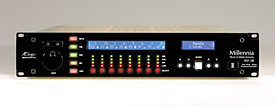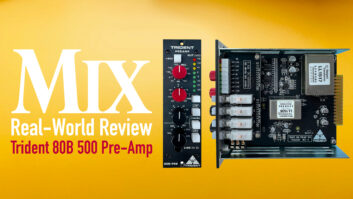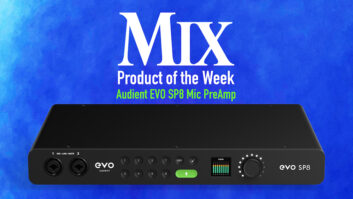
The Millennia HV-3R offers eight clean mic preamps that can be controlled remotely through MIDI, Ethernet or a wireless router.
A manufacturer of no-compromise audio gear for nearly two decades, Millennia Media has previewed its HV-3R multichannel mic preamp at trade shows for the past 18 months; finally it’s here. The unit offers eight of the company’s acclaimed HV-3 preamps in a two-rackspace unit with remote control and companion Ælogic software, allowing for operation of up to 99 units from a computer (792 channels). Options are many, including high-voltage mic inputs (130V/190V, $200/channel), DC inputs for use with dynamic and ribbon microphones ($100/channel), HROE output expansion offering three active isolated outs per channel ($1,500) and the AD-R96 A/D converter card ($1,500). I tested a stock unit with no extras.
Front and Back
The unit is built on a sturdy 16-gauge aluminum chassis with internal power supply and glossy black front plate. There is a handy jog wheel and controls for local operation of the eight channels, with switches for link, mute, phantom power, pad and polarity. The wheel controls gain on any selected channel or linked channel group. The linking reflects any offset on the channels within, making it easy to first adjust these individually and then tweak overall level globally to maintain any gain difference between the channels. Up/down/left/right cursors, an Enter button and small display allow local or remote operation via Ethernet, TC/IP or MIDI. Other preferences (such as naming setups) can also be set here, but I preferred using the included software for this. Unfortunately, the jog wheel is not integrated into the data-entry side of the unit, making it a chore to single-click through upper- and lower-case alphabets and symbols. Millennia says this is intentional because the user may want to control gain while using the data-entry functions. I found it a bad trade-off. The rear panel has XLR I/O, ports for the options mentioned above, power switch and standard IEC power cable.
Remote Possibilities
One of the HV-3R’s slickest features is its remote-control ability. This is accomplished using the Ælogic control software (PC-only) interfaced one of three ways: Ethernet from your computer, MIDI from Pro Tools, or wirelessly via a wireless router (not included). I also took the remote-control scenario up a notch by operating the computer’s trackpad and Ælogic in turn from my iPhone using Snatch, a simple and free app from www.hoofien.com. In Ethernet and Pro Tools control modes, this worked especially well for controlling the HV-3R from anywhere within view of a screen showing Ælogic.
The HV-3R offers the best of all “clean signal” scenarios: placing preamps near the talent and then making long cable runs at line-level. The HV-3R’s FET-based output stage has 32 dB of headroom, effortlessly driving 1,000-foot runs. I used the unit remotely with great results. The difference in quality between local and remote operation was not quantifiable for me because the cable runs I was making were under 50 feet, but I could see this being especially useful in a live or remote recording scenario. The Ælogic software offers control of the unit(s) from any PC or Intel Mac running Parallels or Windows. I used the PC side of a dual-boot Intel Macbook for all my remote applications and it worked without a hitch. From the software you can store as many setups as you’d like, name channels, link, mute, pad, flip polarity and set gain on up to 99 units.
The MIDI option on a Pro Tools TDM system provided equally good results. This was achieved by routing the HV-3R’s MIDI I/Os into the DAW’s MIDI interface I/O, then setting the HV-3R to MIDI remote operation and matching the MIDI channel numbers. I then went to IO/Peripherals in Pro Tools and chose PRE on my first slot, then to Setup/IO, then the Mic Preamp tab and assigned the preamps to an interface. It was that simple. No matter the Pro Tools channel size — 1, 2, 5 or more — the HV-3R assigned the correct number of preamps to the channel. I was able to mute, apply phantom power, swap polarity and adjust gain easily from Pro Tools’ mic preamp section at the top of any IO.
Millennia in Action
My first outing with the HV-3R was on two large tracking sessions with the unit set up in Local mode, where levels and parameters were adjusted using the jog wheel and buttons on the front of the unit. The first session employed the preamps on toms, overheads, a pair of Shure 57s recording a guitar amp (on- and off-axis) and a DI bass input. In all cases, the recordings were clear and punchy with quick transients and little to no “color” provided by the preamps. The bass and guitars were stellar, representing the bottom end admirably and popping the guitars out in the midrange of the mix. During the second session, the preamps were used to amplify two kick drum mics and two snare mics, which were gassed by rare transformer-based SSL 4000 Series console preamps in the earlier session. What was glaringly lacking when I compared tracks from the two sessions was the transformer overdrive and added color of the console’s preamps, which was flattering to the overall sound of the kick and snare, giving the kit plenty of beef. The HV-3Rs were too clean on these drums, sounding better in the first session on the overheads and attack of the toms with the more colorful preamps. This is not a bad thing, but it reveals that this box is a specialty tool to be used where clarity, excellent stereo image and low sonic impact are of utmost importance.
I next used the HV-3R’s Remote mode to record a percussionist in surround, setting the preamps near the mics after a short mic-level cable run. My setup comprised five SE Electronic SE-3 small-diaphragm condenser mics arranged in a tight circle at 30 degrees left and right, 0 degrees center, and 110 degrees for the Ls and Rs. I also used a Neumann U87 as a roving LFE mic. I had an old D-Link wireless router at home that I brought in to put the HV-3R on its own network. I plugged the router into the HV-3R’s Ethernet port and put the unit in remote LAN mode from the front panel. Next, I made sure that my Intel Mac, booted into Windows XP, recognized my network and I was ready to go.
Once I opened the Ælogic software, I could adjust levels and parameters using the computer. I grouped my five L, C, R, Ls and Rs channels, named them appropriately and saved a session setup. It was easy to adjust levels for different instrument overdubs by moving just one of the grouped faders until the hottest channel was where I wanted it. The tracks were stellar with hand percussion, including triangle, shakers, cajon and other toys, sounding like the player was in the room. The unit rendered the transients accurately with plenty of headroom and beautifully rendered top end without any smear, and it created a great 5.1 representation of the room with clear and accurate off-axis information.
Clear Choice
I absolutely loved working with the HV-3R. I was repeatedly spoiled by the quality of my tracks and the different ways I could set up and control the unit. Yes, the data entry on the unit was clunky, but this issue went away when I used the unit remotely. One warning would be to have plenty of room around the HV-3R and a fan if you’re going to mount it in a rack: This baby gets hot! If you’re balking at the price, think of it as a $700-per-channel box with plentiful (and included) remote-setup possibilities, plus a lot of great optional extras for future expansion. For anyone working remotely, live and/or using Pro Tools, or just wanting a rock-solid front end that will record exactly what your mics are capturing, this is the box for you.
Kevin Becka is Mix’s technical editor.








